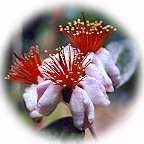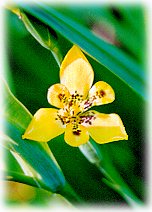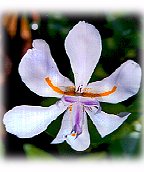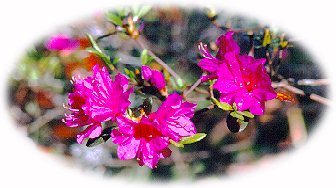 Jim Notestein, in His Own Words Garden Designer & Horticultural Advisor Call (352) 372-2107 for an appointment |
|||

Family HistoryJAMES EDISON NOTESTEIN is a fifth-generation Floridian, owing to his mother's ancestors — McClellan, Harris, and Bacon — who came to Sarasota after the Civil War had devastated Tupelo, Mississippi. Mrs. Bacon was diagnosed with tuberculosis and her physician's remedy was to move to the "piney woods" of Florida.The Bacon family traveled by ox-drawn wagons for nearly two-years, because of the primitive trails. Part of that trail system came down what we know now as State Road 121 — sometimes called the Woodpecker Trail — characterized by vast, open, pine flatwood-grasslands that dominated Florida's central ridge, also called the Crown Region. In this wildfire-managed bioregion of North Central Florida, the social, cavity-nesting bird clans favored the once-abundant, lightning-killed, standing snags for their dwellings. With no stores along the way, the Bacon family would periodically make extended camp to raise root crops and squashes — adding to the wild game and edible native plants they foraged. This same route was taken by William Bartram in 1774 as he sought botanical specimens for his father in England. He came as far south and west in Florida as the Kanapaha area that we know now as Kanapaha Botanical Gardens. A historic marker near the water lily gardens at KBG briefly recounts his visit. With many ups and downs, the Sarasota colonists carved out a settlement in what first became known as "Bucket Town." (A company set up to harvest the cedars made them into commercial buckets by the thousands.) As with Cedar Key, the Sarasota area was lush with giant southern red cedar trees. Real estate developers couldn't see much of a property market using the name Bucket Town. So they began a charming fabrication. Everyone remembers Hernando deSoto, ruthless Spanish gold-seeker and Indian killer. Perhaps he had a daughter. Perhaps her name was Sara. Thus began a picturesque fable of Sara deSoto. It was subdivisions from then on out. Like most of us, Jim's ancestors scratched out vegetable gardens for more than recreation. They had to hand-dig their own wells. But nearly all his Florida people were horticulturally inclined. Some of them worked with Thomas Edison in his search for the first light bulb filament and with A.I.Root, the pre-eminent American beekeeper. Edison's winter home in Fort Myers still has one of America's largest collections of plant material — some six-thousand specimens. Bamboo proved to be the best candidate for carbonized whiskers of practical illumination. Edison also used bamboo instead of reinforcing steel to imbed in his above-ground swimming pool in Fort Myers. To this day, there are no cracks in the pool structure — something steel could not duplicate.
Early influences Jim's paternal great-grandfather planted the first royal palms in Florida. Many of these elegant and
shapely giants still line the major boulevards of Bradenton. This ancestor also experimented with citrus
and had large groves in western Manatee County.
Jim's paternal great-grandfather planted the first royal palms in Florida. Many of these elegant and
shapely giants still line the major boulevards of Bradenton. This ancestor also experimented with citrus
and had large groves in western Manatee County.
While in grammar school, Jim was regularly placed with his father's aunt, from whom he learned most every useful skill and craft except metal work and building construction. These last talents were imbued by his father and a maternal great-uncle, with whom several homes were built and many vintage automobiles altered. It was from the great-aunt, May Notestein, a gentle and encyclopedic teacher, that Jim learned principles of plant life at her Bradenton home. With May, it was a long-term adventure of science and persistence: cross-pollinating amaryllis blossoms, carefully edge-planting the large, black, circular, tissue-thin wafer seeds, and several years later finally enjoying unique color expressions of their mixed parents. And in between — painting images of mature plants on canvas, making original and unique ceramic plates with floral relief, and even weaving on the loom fabrics with a botanical flavor. Along with these lessons came the pleasure and magic of baking bread, listening to grand stories, and gradually becoming a person with a love of the natural world. Jim learned from his great-uncle Earl, a carpenter, how to double-ring-cut the cambium from crotons and "moss-them-off." Otherwise called air-layering, this technique of plant reproduction allows a large root formation to occur in a air-tight bag of damp spaghnum. After a month or so, this ready-to-pot specimen, several feet tall, can be cut from the mother-plant, with no shock to either.
On his own... Science, engineering and architecture called Jim to the University of Florida in 1961. Missing an
opportunity to pursue technical horticulture, for which he was aptly prepared, Jim imagined to become
an astronaut. But that never took off.
Science, engineering and architecture called Jim to the University of Florida in 1961. Missing an
opportunity to pursue technical horticulture, for which he was aptly prepared, Jim imagined to become
an astronaut. But that never took off.
A youthful will-o-the-wisp went as far west as Route 66 would go — working in the planning department of a multi-county park and open-space district in Oaklands' East Bay Region, community gardening in heavy clay soils of Berkeley, manufacturing stadium-scale sound projectors, dancing with freedom-fighters of the love-generation, visiting the same old-growth redwoods as John Muir, discovering the wild Pacific coast of Lewis and Clark, and camping in snow atop glacier-split Half- Dome in Yosemite. Something was missing...something was calling home.
...but not for longJim's good fortune was to be discovered by Emily — an encouraging spirit — with whom an interest in things green and growing began to unfold. "Woodland Echoes," their homestead near Gainesville's Rattlesnake Branch of Hogtown Creek, became the foundation for walking the talk of advocacy gardening, renewable technologies, and applied citizenship. Together, they helped develop the first Farmers Market Gainesville had known in one hundred years.

In business and in the communityWith a modest investment in truck, tiller and tools, Jim started hundreds of small, backyard vegetable gardens for local folks wanting the many benefits of growing their own.Jim was a vocational horticulturist at an experimental treatment facility that demonstrated positive behavior modification among variously-challenged individuals. To help launch the local affiliate of National Public Radio, Jim was recruited to create and produce the Florida Plant Kingdom, a weekly guide to horticultural pleasure and success for listeners from coast to coast (Gulf to Atlantic). Many of Jim's broadcasts have been published in six different regional periodicals. He has been a member of the National Garden Writers Association. With a nod from the Jeffersonian inspiration, Jim left his farmstead to serve a term of elective office as Alachua County Commissioner. Growth management, natural resource conservation, economic initiatives, intergovernmental cooperation, energy and material innovation, fiscal responsibility, establishing a county-wide library district, and diplomatically protecting the public interest were hallmarks of Jim's community service. Jim has maintained an effective relationship with the Florida Cooperative Extension Service, many departments of the University of Florida's Institute of Food and Agricultural Sciences, the State of Florida's Division of Forestry, and Florida's Division of Plant Industry. A member of the Florida Native Plant Society, Jim enjoys collaborating with the Front Runners Chapter of the Florida Nursery and Growers Association, and the Association of Florida Native Nurseries.
Over the years, as citizens and visionary representatives have gathered to discuss and promote
sustainability and community development, Jim has played an active role to encourage the grassroots
approach to building the future.
pineapple guava (Feijoa sellowiana), yellow walking iris (Trimezia martinicensis), African white iris (Dietes iridioides), azalea (Rhododendron simsii). |
Services offered
Landscape design
Areas of special expertise |
||
  Available plant list Return to Home Page |